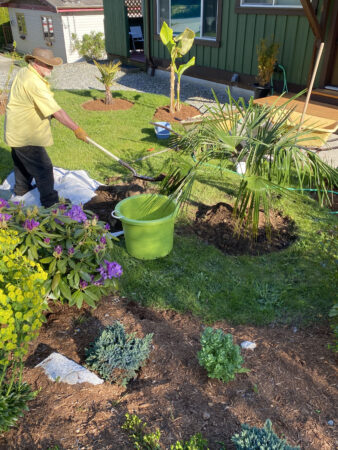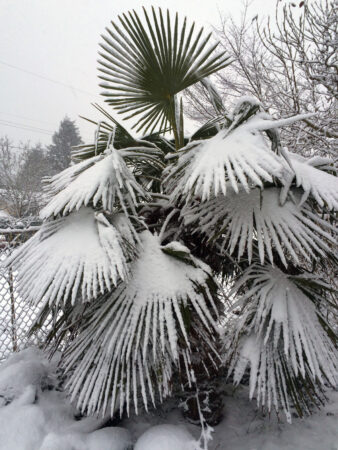Planting
Choose a site: Palms do well in full to part sun and in average soil with good drainage. They thrive in moist, but not heavy, wet soil. Choose a site that is somewhat sheltered from strong winds.
 Clear the site: Remove all weeds, debris and rocks to make way for the palm.
Clear the site: Remove all weeds, debris and rocks to make way for the palm.
Dig: Dig a hole at least 15 cms wider than the width of the palm root ball.
Fertilize: Put a handful of evergreen fertilizer into the bottom of the hole and mix in with the soil in the hole.
Water: Water the bottom of the hole until it is saturated.
Tease the roots: Once the palm is out of its pot, tease the roots apart a little with your hand or a garden tool.
Place the palm: The top of the root ball should be about 4 cm above the height of the surrounding soil. Make sure the palm is centered and the trunk is straight.
Fill with soil: Be careful not to plant the palms too deep. Make sure that only the roots are covered in soil and not the husk or trunk. Tamp down the soil.
Fertilize: Add another handful of evergreen fertilizer on the surface of the soil you have just added.
Build a moat: Build a ridge of soil around the base of the plant to hold water in.
Water: Give the palm a generous amount of water. Use a 20-litre bucket of water to give a heavy dousing. An abundance of water helps the palm grow a good root system.
Mulch planting area: Put a 6cm layer of mulch on top of the soil around the newly planted palm. Make sure the mulch is just touching the base of the trunk. The mulch will help retain the moisture in the soil. It will also help protect the roots of the palm in the winter.
Spacing: If you are planting a group of Windmill Palms, be sure to plant 2 metres to 3 metres apart. This will help give them space to grow and allow each palm to get the water and nutrients from the soil they need without competition.
Care
 Protection: When planting Windmill Palm trees in the garden, the young palms need protection from the cold. If temperatures below -5 degrees Celsius threaten, it is recommended that several wraps of burlap from the bottom up to cover 3/4 of the palm are used.
Protection: When planting Windmill Palm trees in the garden, the young palms need protection from the cold. If temperatures below -5 degrees Celsius threaten, it is recommended that several wraps of burlap from the bottom up to cover 3/4 of the palm are used.
Windmill Palms fronds can handle the weight of some snow, so they are a great winter feature in the garden. If, however, snow load becomes heavy, it is worth it to remove the snow with a broom.
Watering: Moisture in the soil helps Windmill Palms grow and improves their quality. They are a drought tolerant plant, but lack of water will significantly impede growth. A well cared for palm can eventually reach a height of 8 to 10 metres.
After planting a palm in the garden, water it heavily twice a week for the first few months. After that, a weekly deep watering will suffice for the rest of its first year in the ground. In the summer, two waterings a week are often required for your new palm. Make sure the soil is always damp but not soggy.
 Fertilizing: Windmill Palms respond well to a slow-release evergreen fertilizer two times a year during the growing season. Fertilize in spring before the new growth at the end of March and then again in the summer, at the end of June.
Fertilizing: Windmill Palms respond well to a slow-release evergreen fertilizer two times a year during the growing season. Fertilize in spring before the new growth at the end of March and then again in the summer, at the end of June.
Insects and Diseases: Windmill Palms can be affected by scale and are also susceptible to root rot. Leaf spot can be caused by sudden drought like symptoms.
Pruning: Except for watering, Windmill Palms are a low maintenance tree. They require no pruning, however, once a year the seed pods can be removed when they go brown. If so desired, you can remove dead or brown fronds.
Container Windmill Palms: If you want to keep your Windmill Palms in a container, they respond extremely well. Just be prepared to move the container palm to a garage in the winter months to keeps the roots from freezing.
WATCH THE PLANTING PROCESS
